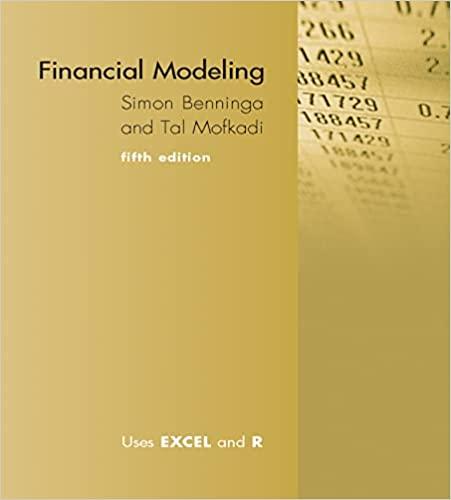Question
consider the following project for your firm. an initial investment of $1 million will generate expected unlevered pre-tax cash flows (ucf) of $300,000 per year
consider the following project for your firm. an initial investment of $1 million will generate expected unlevered pre-tax cash flows (ucf) of $300,000 per year in perpetuity. the firm will finance this project maintaining its capital structure with equal proportions of debt and equity. three of your firm's closest competitors have unlevered betas of respectively 1.2,1.3, and 1.4. these firms are approximately equal in size. the risk-free rate is currently 5%, while the expected return on the s&p 500 index is 14%. the corporate tax rate is 34%. the firm can borrow risk-free.
viii. Using the average business risk of your competitors as a proxy for your business risk, what is the levered beta you should use for the project?





xiii. What are the levered cash flows to equity (LCF) used in the FTE in t=1, ?

xiv. What is the initial equity investment for this project if the NPV of this project is $400,000, regardless of whether this is correct or not?

xv. In order to use the Flow-to-Equity approach to value this project, your discount rate should be:
For this question, from the options below, select the letter associated with the correct answer.


Select) [ Select] 1.277 1.3 1.729 2.158 3.9 ix. Based on the CAPM, what is the appropriate cost of equity (Re) if the firm uses its own estimate for business risk based on an asset beta of 1.3 instead of using the average business risk of its competitors as a proxy? Select) Select] 24.422% 16.7% 35.212% 13.861% 18.12% POSSET x. What is the RWACC? Select [ Select ] 16.7% 13.9% 21.5% 24.4% 35.2% xi. What is the NPV of this project? Select) [ Select ] $428,468 $1,428,468 $1,192,982 $2,192,982 -$189,256 borrc CIELE xii. How much should the firm borrow to finance this project and maintain its capital structure target if the NPV of this project is $400,000, regardless of whether this is correct or not? Select) [ Select ] $700.000 $500,000 Nothing - they should reject the project anyhow. Nothing, as it would not be beneficial to shareholders to use debt $200,000 FTE in t=1, o? PI Select) [ Select ] (1 -0.34) * ($300,000 - Interest Expense) (1 -0.34) $300,000 ((1 - 0.34) * $300,000) - Interest Expense $300,000 - Interest Expense ($300,000 / (1 -0.34)) Interest Expense Select) [Select ] $300,000 $500,000 $700.000 14 Nothing as it is better to use debt $1 million IS a. R b. R. C.R. d. Racc e. Rasx_FREE e Select) [ Select ] a b d e xvi. To use the APV method to value this project, you need the following following inputs for the cash flow (C), discount rate (r) and add the Tax Rate x D (where D=debt). What are the C and r values here for the APV? Select [Select C(O)- $1 million, C(1, -->) - $198.000; r-16.7% C(O)--($1 million-D), C(1, -->) - $198,000; r-16.7% C(O)- $1 million, C(1, -->) - $300,000; r-16.7% Clo) --$1 million, C(1, -->) - $198,000; r-Rwacc Clo) --$1 million, C(1, -->) - $300,000; r-Rwacc Select) [ Select] 1.277 1.3 1.729 2.158 3.9 ix. Based on the CAPM, what is the appropriate cost of equity (Re) if the firm uses its own estimate for business risk based on an asset beta of 1.3 instead of using the average business risk of its competitors as a proxy? Select) Select] 24.422% 16.7% 35.212% 13.861% 18.12% POSSET x. What is the RWACC? Select [ Select ] 16.7% 13.9% 21.5% 24.4% 35.2% xi. What is the NPV of this project? Select) [ Select ] $428,468 $1,428,468 $1,192,982 $2,192,982 -$189,256 borrc CIELE xii. How much should the firm borrow to finance this project and maintain its capital structure target if the NPV of this project is $400,000, regardless of whether this is correct or not? Select) [ Select ] $700.000 $500,000 Nothing - they should reject the project anyhow. Nothing, as it would not be beneficial to shareholders to use debt $200,000 FTE in t=1, o? PI Select) [ Select ] (1 -0.34) * ($300,000 - Interest Expense) (1 -0.34) $300,000 ((1 - 0.34) * $300,000) - Interest Expense $300,000 - Interest Expense ($300,000 / (1 -0.34)) Interest Expense Select) [Select ] $300,000 $500,000 $700.000 14 Nothing as it is better to use debt $1 million IS a. R b. R. C.R. d. Racc e. Rasx_FREE e Select) [ Select ] a b d e xvi. To use the APV method to value this project, you need the following following inputs for the cash flow (C), discount rate (r) and add the Tax Rate x D (where D=debt). What are the C and r values here for the APV? Select [Select C(O)- $1 million, C(1, -->) - $198.000; r-16.7% C(O)--($1 million-D), C(1, -->) - $198,000; r-16.7% C(O)- $1 million, C(1, -->) - $300,000; r-16.7% Clo) --$1 million, C(1, -->) - $198,000; r-Rwacc Clo) --$1 million, C(1, -->) - $300,000; r-Rwacc
Step by Step Solution
There are 3 Steps involved in it
Step: 1

Get Instant Access to Expert-Tailored Solutions
See step-by-step solutions with expert insights and AI powered tools for academic success
Step: 2

Step: 3

Ace Your Homework with AI
Get the answers you need in no time with our AI-driven, step-by-step assistance
Get Started


